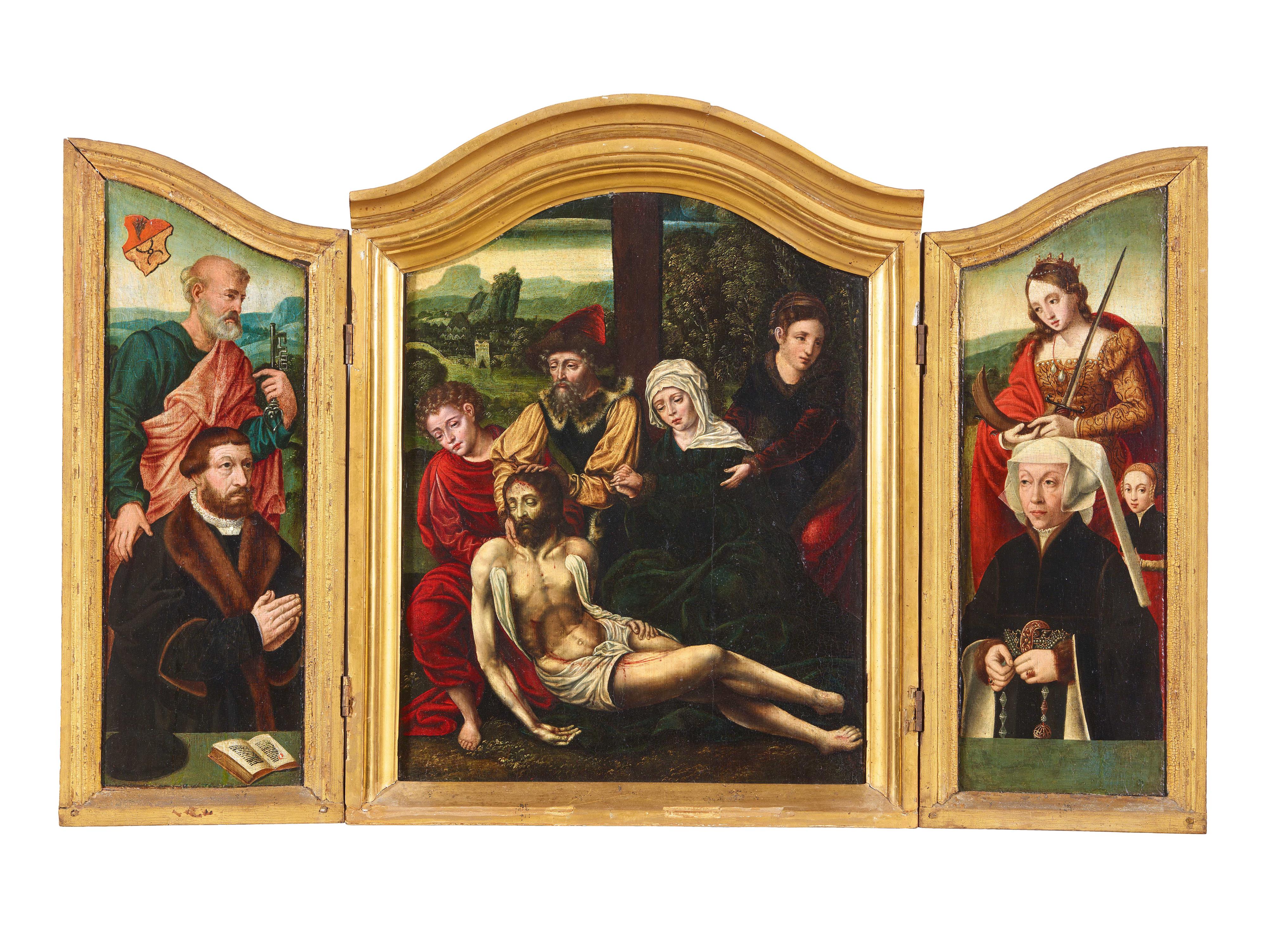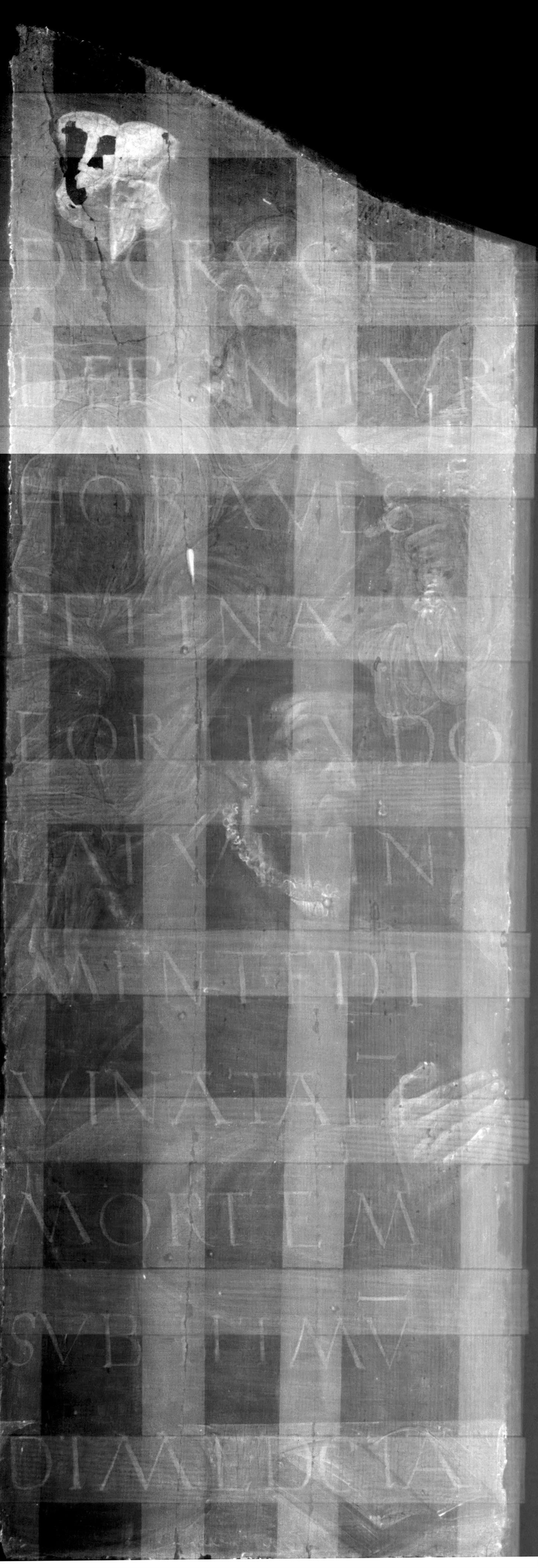Antwerp School
Bartholomaeus Bruyn the Elder, studio of
Flemish Triptych with the Lamentation and Cologne Donor Portraits
Oil on panel (parquetted). Central panel 53 x 41.5 cm, outer panels each 53 x 19 cm.
This Flemish-Rhenish triptych is a fine example of a "bicultural" work. The painting, which is highly interesting from an art-historical point of view, was created in Antwerp around 1530-40 and was embellished with portraits of donors in the workshop of Bartholomäus Bruyn in Cologne a short time later. Dr Didier Martens of the University of Brussels (ULB) is preparing a paper on this phenomenon, publishing this as well as other hitherto unrecognised examples of Flemish-Rhenish triptychs. We have him to thank for the following catalogue entry:
"The triptych was painted in Antwerp. In terms of composition, the Lamentation of Christ on the central panel can be associated with works by both Quinten Massys and Josse van Cleve. Stylistically, however, it is closer to Josse van Cleve because of the fuller heads. At first it was a so-called inscription triptych, a relatively rarely attested form of the Old Netherlandish triptych. In such works, only the central panel has a figurative representation. On the wings there is only text, in most cases a Bible passage or a prayer, always in Latin. Such triptychs were rather small in size and probably functioned as domestic altars.
In the case of this triptych, the text has been completely painted over. Thanks to the x-ray (ill. 1), it is nevertheless legible : Left wing : " De cruce / deponitur hora ves/pertina / fortitudo / latuit in / mente di/vina tale(m) / mortem / subiit mu(n)/di medica " ; Right wing : " Tande(m) ho/ra debita / datur se/pulturae / : corpus [Christi nobi]/le spes vi/te future / conditur / aromate com/plentur scr(iptu)r(ae) ". The intended text, a poem, is from an Officium sanctae Crucis associated with Pope John XXII (1336-1364). He would have had this Officium, which was not well known before his time, circulated. The text itself was included in several books of hours and breviaries of the late Middle Ages. For a full edition of the text see G.M. Dreves, Reimgebete und Leselieder des Mittelalters. Dritte Folge : Stunden-und-Glossen-Lieder, Leipzig 1898, pp. 33-34. This information has been provided by Dr. R. Godding (Brussels, Société des Bollandistes). The commissioner of the triptych may have requested this particular extract. In terms of content, it fits perfectly with the depiction on the central panel, referring to the taking down of the cross and the burial of Christ's body.
A few years after its completion, the Flemish triptych was brought to Cologne. There it was adapted to the wishes of a local family. The Latin text then had to give way to portraits of donors with their patron saints. The execution of these figures can be attributed to a painter from the workshop of Bartholomäus Bruyn the Elder. The new owner of the triptych, who also requested the addition of his coat-of-arms, had himself depicted with Saint Peter on the left wing. The right wing shows his wife with their young daughter, both under the protection of Saint Catherine. The triptych probably fulfilled the function of an epitaph in a chapel after the death of the family. The theme of the Lamentation of Christ was of course also very well suited to the new function of the triptych.
There are other examples of Flemish triptychs that were provided with donor portraits in Cologne. Thus, "bicultural" works were created which are indebted to both the Flemish and the Rhenish tradition (for more on this phenomenon see: K. Löcher, Ein niederländischer Dreikönigsaltar des 16. Jahrhunderts im Kölner Dom und verwandte Altarretabel in Kölner Kirchen, Kölner Domblatt 67, 2002, pp. 195-222)."
The donor's coat-of-arms has not yet been identified. X-ray and infrared images also show old alterations. According to the Cologne Historical Archive, the heraldry does not belong to one of Cologne's great old families. The lower part could be a craftsman's or house mark, which would then speak for a rich family from the middle income segment. The motif of the mill iron in the lower part is also used in the coat-of-arms of the von Hatzfeld family. Whether there is a connection here requires further investigation. A note on this question of heraldry is available on request.
COMPARISON ILLUSTRATION
Fig. 1/Ill. 1: Infrarotaufnahmen der Seitenflügel / Infrared images of the side wings (David Strivay, Université de Liège)
Provenance
Belgian private collection.






